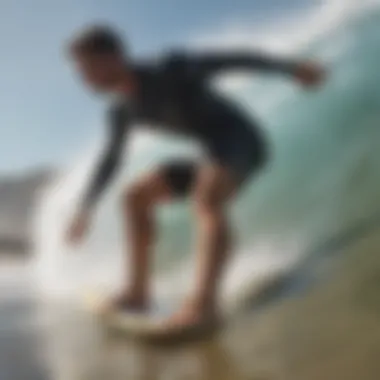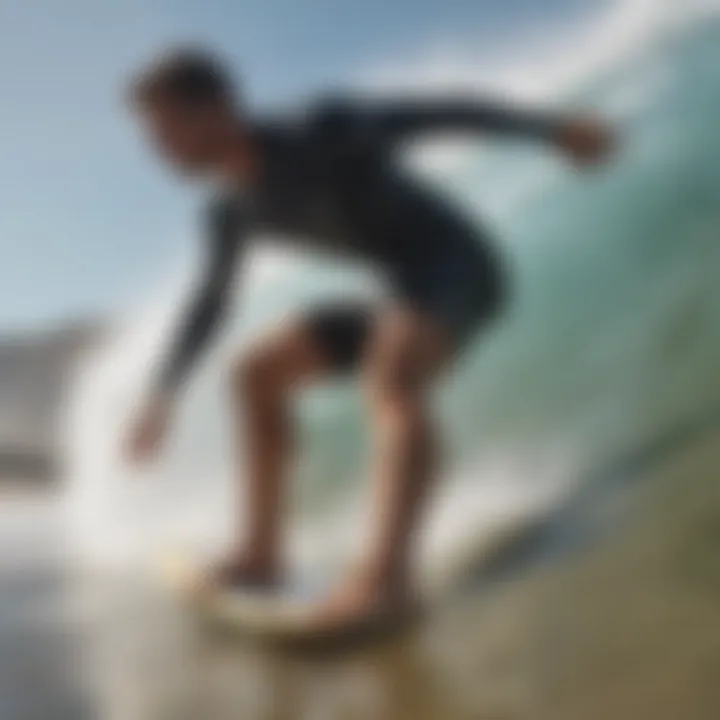Effective Strategies to Avoid Calf Cramps While Surfing


Intro
Calf cramps can truly put a damper on an otherwise exhilarating day of surfing. Picture this: you catch a wave, riding it beautifully, and then—bam!—a sudden, painful cramp hits your calf. Not only does it yank you out of the flow, but it can also lead to fatigue and even safety concerns in the water. Understanding how to prevent these cramps is essential for anyone keen on maximizing their time in the surf.
This article dives deep into the strategies that surfers can use to dodge those unwelcome cramps. From nutrition choices that fuel your body to effective dynamic stretches that keep your muscles limber, we’ll cover a wide range of tactics. Also, we’ll touch on hydration practices, warm-up routines, and lifestyle adjustments that enhance your performance, allowing you to dive headfirst into your passion without fear of physical limitations.
Let’s be clear: preventing calf cramps isn't just about dealing with discomfort—it's about ensuring that every ride on your board is full of joy and not marred by pain. By weaving a few key practices into your routine, you can ensure smoother sessions and more time spent mastering those skills out in the waves.
Surfboarding Techniques
Surfers, whether novices or experienced, share a common thread that binds them—the desire to ride the waves smoothly and confidently. Mastering certain techniques can not only improve your performance but will also play a significant role in preventing calf cramps.
Beginner Tips for Mastering the Basics
For those just starting, it's essential to get the fundamentals right. This means paying close attention to how you position your feet on the board. Inadequate foot positioning can lead to unnecessary strains on your calf muscles. Here are some pointers for newcomers:
- Wide Stance: When you’re balancing on your board, ensure that your feet are spaced evenly apart. A wider stance spreads out the workload on your muscles.
- Weight Distribution: Keep your weight centered. Leaning too far back or forward can lead to excessive muscle tension.
- Engage Your Core: A strong core stabilizes your body, reducing the burden on your calves.
Advanced Techniques for Seasoned Surfers
For those seasoned in the surf, refining your technique can further stave off calf cramps.
- Balance Practices: Engage in balance-training exercises. The more adept you become at shifting your weight smoothly, the less strain you put on your calves.
- Breath Control: Improper breath control can lead to tension in your body. Focus on breathing steadily while you ride, which can help maintain relaxation in your muscles.
- Board Control: Mastering moves like turning, trimming, and landing will aid in distributing loads more efficiently through your legs. A well-executed bottom turn, for example, keeps your weight over your board, reducing strain.
Utilizing these strategies doesn't just keep cramps at bay; they help cultivate a more enjoyable and fulfilling surfing experience.
"With every maneuver, the goal is not just to perform but to find a synergy with your board and the elements around you."
The End
Navigating your way through the wonderful world of surfing comes with its challenges. Calf cramps can be one of them, but with a thorough understanding of proper techniques and incorporating preventive measures, you can significantly mitigate that risk.
As we dive deeper into specific strategies, remember that every surfer's body is different. What works wonders for one might need tweaking for another. Thus, being attentive to your body and continuously adjusting your approach will serve you well in your surfing journey.
Prolusion to Calf Cramps
Calf cramps represent a common yet vexing issue faced by surfers. They can strike when least expected, turning a perfect day on the waves into a painful ordeal. Understanding the nuances of calf cramps is not merely a matter of personal comfort; it directly correlates with one’s surfing performance. The ability to ride those waves without the distraction of muscle cramps can enhance not only skill development but also overall enjoyment of the sport.
Definition of Calf Cramps
Calf cramps, in simplest terms, are involuntary muscle contractions that typically happen in the calf muscles at the back of the lower leg. These contractions can feel quite extreme, often manifesting as a tight knot or a twitching sensation. Anyone who’s had one knows it can stop you in your tracks. Calf cramps are more than just a nuisance; they can also pose risks, such as falls or injuries while maneuvering on a board.
Common Causes of Calf Cramps
Understanding what drives these cramps is crucial for prevention. There are several factors that might be at play:
- Dehydration: Surfers often spend long hours in the sun and saltwater, which can sap hydration levels. When muscles don’t get enough fluid, cramps might show up as a cruel reminder.
- Electrolyte Imbalances: Low levels of potassium, sodium, or magnesium can contribute to those nasty tight muscles. Surfing takes a toll on these electrolytes, so keeping them balanced is vital.
- Inadequate Warm-Up: Jumping straight into surfing without a proper warm-up can send calf muscles into shock. They need to gently wake up to get ready for action.
- Fatigue: Long sessions on the water can lead to overworked muscles. Tired muscles are prone to cramping as they tire quickly and may not receive necessary nutrients and blood flow when overextended.
Identifying these common causes gives surfers a solid foundation to tackle calf cramps effectively. It’s not just about knowing what they are, but understanding how to prepare and respond to prevent these unwelcome muscle contractions.
Understanding the Anatomy of the Calves
To effectively address calf cramps while surfing, it’s crucial to grasp the anatomy of the calves. This knowledge serves as a foundation for understanding why calf cramps occur and how to prevent them. The calves play a pivotal role in various activities, including surfing. Hence, knowing how they work can guide surfers towards better practices to minimize discomfort.
Muscle Structure and Function
The calf muscles, primarily made up of the gastrocnemius and soleus, work together to enable movement and stability. The gastrocnemius is a larger muscle, prominent at the back of the lower leg, while the soleus lies beneath it. These muscles assist in movements like plantar flexion, which is crucial when pushing off the board, paddling, or adjusting your stance while riding a wave.
A clear understanding of their structure helps in recognizing how they respond to stressors—such as overuse, dehydration, or improper warm-up routines. When not properly prepared, they can easily tighten up or cramp, leading to a disruption in surfing performance.
Moreover, these muscles are not just for show; they assist in maintaining balance on your board and contribute to explosive power during maneuvers. A stronger understanding of muscle function can drive surfers to engage in targeted exercises that bolster calf resilience, reducing the likelihood of cramps.
Role of Calves in Surfing
In the world of surfing, calves are real unsung heroes. They not only help in maintaining balance on a surfboard but also are crucial in pivoting and turning. Every time a surfer initiates a turn or pushes against the wave, the calves spring into action.
Additionally, when surfers are catching a wave, the calves endure considerable strain. The repeated motion of paddling, getting back on the board, and riding the waves can place great demands on these muscles. This repetitive use can lead to fatigue, particularly if the muscles are not adequately conditioned or hydrated.
Understanding the anatomical role of calves can lead to improved performance. A well-nurtured calf can handle stressors better, ultimately enhancing the surfing experience.
Surfers often overlook calf care, but it's vital. Proper warm-up exercises and stretches targeting the calves can significantly enhance muscle functionality and endurance. Balancing strength and flexibility is key; a well-rounded approach gives surfers an edge, making their time on the water more enjoyable.
By comprehending the anatomy and function of the calves, surfers can implement proactive strategies that not only prevent cramps but also boost their overall surfing game.


Nutritional Considerations
When it comes to preventing calf cramps during surfing, what you eat plays a vital role. Nutrition isn't just about keeping your body fueled; it significantly impacts how well your muscles perform. Surfers often face unique challenges in maintaining their strength and endurance in the water, making dietary considerations all the more essential. Let’s break down how specific nutrients influence muscle function and help enhance performance in the ocean.
Influence of Electrolytes on Muscle Function
Electrolytes, such as sodium, potassium, magnesium, and calcium, are key players in muscle contraction and relaxation. When you're out surfing, your body loses fluid through sweat, which can lead to an imbalance of these vital minerals.
The consequence? A higher likelihood of muscle cramps, especially in the calves.
Therefore, it's crucial for surfers to replenish their electrolyte levels before, during, and after a surf session. Here are a few practical ways:
- Sports Drinks: Consider hydrating with drinks that contain a good balance of electrolytes, like Gatorade or Propel.
- Natural Sources: Foods such as bananas, spinach, and coconut water are not just tasty but packed with potassium and other essential minerals.
- Salt Additions: Just the right amount of salt (sodium) in your meals can help hold onto fluids, ensuring that electrolytes remain stable during those long hours of paddling.
"Staying hydrated and keeping those electrolytes in check is vital. It's as important as your wetsuit when catching those waves."
Importance of Calcium and Vitamin
Calcium and Vitamin D work hand in hand to keep your bones and muscles healthy, which is particularly important for surfers who rely on powerful, agile movements. Calcium helps build strong bones and, interestingly, also plays a role in muscle contractions.
Meanwhile, Vitamin D enhances calcium absorption and supports muscle function. Without adequate levels of calcium, your body might face difficulties contracting those calf muscles effectively, leading to cramps when you're trying to ride the wave.
To ensure you're getting enough of both, consider:
- Dairy Products: Yogurt and cheese are excellent sources of calcium.
- Fatty Fish: Salmon and mackerel not only provide Vitamin D but also omega-3 fatty acids, supporting overall cardiovascular health.
- Sun Exposure: Don't forget to soak up some sun! Just a bit of daily sun can help your body produce its own Vitamin D.
Dietary Recommendations for Surfing Enthusiasts
To navigate the waters without cramping up, an effective diet is key for surfers. Incorporating a variety of nutrients into your daily meals will promote muscle health, boost energy levels, and contribute to overall wellness in the ocean.
Consider these recommendations:
- Balanced Meals: Each meal should include a carbohydrate source (like rice or whole grains), a good protein (like chicken or beans), and plenty of vegetables for vitamins and minerals.
- Pre-Surf Snack: A light snack before heading out can ensure you have the necessary energy. Think of a banana with some nut butter or a piece of whole-grain toast topped with avocado.
- Post-Surf Recovery: After a surf session, refuel with a meal high in protein and healthy fats. Tuna salad with chickpeas and spinach could serve as a perfect example.
Maintaining a well-rounded diet will help surfers fend off calf cramps. Paying attention to what goes on your plate could very well be the difference between a great surf day and a painful experience.
Implement these nutritional strategies and keep your muscles happy, so you can spend more time riding those waves and less time worrying about cramps!
Hydration Strategies
Hydration is a cornerstone in the arsenal against calf cramps for surfers. When you’re riding the waves or paddling out, your body loses water through sweat and exertion. If you fail to replenish those fluids, you're setting yourself up for a world of discomfort. Cramps can turn a perfect day of surfing into a battle against your own muscles, making staying hydrated not just a suggestion but a necessity. Let's break down how to achieve optimal hydration leading up to and during those exhilarating surf sessions.
Understanding Dehydration and Muscle Cramps
Dehydration is more than just feeling thirsty. It affects your entire system. When you dive into the ocean, your body needs enough fluids to maintain electrolyte balance, which is crucial for muscle function. Without proper hydration, your muscles become irritable and more prone to cramping.
A study highlighted that dehydration can decrease your muscle endurance significantly. Even losing about 2% of your body weight in fluid can lead to poor performance and increase susceptibility to cramps. This means that if you're a 160-pound surfer, losing roughly 3.2 pounds due to dehydration could be detrimental. Keeping an eye on fluid intake is vital.
"Hydration is not just about drinking water; it's about keeping all your body's systems running smoothly."
Optimal Hydration Techniques Before Surfing
Preparing for a surf session is about more than just grabbing your board and heading out. Here are a few hydration techniques to consider:
- Start Early: Begin hydrating the day before your surf trip. Drink water consistently and try to aim for at least 12-16 ounces of water for every hour you spend outdoors.
- Electrolyte Drinks: Consider drinks that replace lost electrolytes. Products like Pedialyte or coconut water can help balance sodium and potassium levels, crucial for muscle function.
- Monitor Your Urine Color: A quick check of your urine can give an indication of your hydration level. A light straw color is ideal, whereas dark yellow can suggest you need to drink up.
- Consume High-Water Foods: Incorporate fruits and veggies with high water content in your meals, such as watermelon and cucumbers. This not only helps hydration but provides essential vitamins as well.
Hydration During Surf Sessions
Once you’re in the water, maintaining hydration becomes a bit trickier, but it’s just as important. Here’s how to approach it:
- Set a Timer: It’s easy to lose track of time while surfing. Try to sip water every 15-20 minutes, even if you don’t feel overly thirsty.
- Take Breaks: When you paddle in for a breather, grab your water bottle. This short pause isn’t just good for recovery; it’s your chance to hydrate.
- Carry a Hydration Pack: Depending on the conditions, a hydration pack can be practical. This allows for easy access to water without needing to exit the water or struggle with a bottle.
- Stay Aware of Saltwater Effects: While surfing, your body may compensate for saltwater intake by filtering more fluids. It’s essential to counteract this by replenishing with freshwater.
The pursuit of hydration strategies is not merely a check box on your surf prep list. It’s a thoughtful integration into your entire surfing experience, amplifying performance and prolonging the fun in the waves.
Warm-Up Routines
Warm-up routines serve as the bridge between a surfer's daily life and the electrifying thrill of the ocean. They are pivotal in preparing the body for the physical demands of surfing, particularly in avoiding calf cramps, which can quickly turn fun into frustration. These routines not only enhance performance but can also significantly reduce the risk of injury by ensuring muscles are activated and ready for action.
Importance of Proper Warm-Up
A proper warm-up effectively increases blood flow to the muscles, enhances flexibility, and raises the overall body temperature. This increase in temperature prepares the muscle fibers for the strenuous activity to come. For surfers, who often engage in explosive movements, the importance of warming up cannot be overstated.
Moreover, the mental element should not be overlooked. Taking time to warm up establishes a focused mindset, allowing surfers to mentally transition from shore to waves. A few minutes spent warming up can also help identify any tightness or imbalances within the body, which is often a precursor to muscle cramps.
In short, the right warm-up routine can lead to better performances and an enjoyable time on the surfboard, rather than cutting the session short due to cramps or strains.


Effective Warm-Up Exercises for Surfers
Engaging in a series of targeted warm-up exercises can set the stage for an energetic and cramp-free surfing experience. Here are several effective warm-up exercises that surfers can incorporate into their routine:
- Leg Swings: Stand holding onto a wall for support, swinging one leg back and forth in a controlled manner. This helps to mobilize the hip joint and stretch out the calves in preparation for the board's movements.
- Calf Raises: Standing tall, raise your heels off the ground and then lower back down slowly. This simple action warms up the calf muscles while increasing their blood flow and elasticity.
- Lunges with a Twist: Step forward into a lunge, and then twist your torso towards the leg that is forward. This dynamic stretch warms up the hip flexors and activates the calves effectively.
- Ankle Circles: Lift one foot off the ground and draw circles in the air with your toes. This exercise helps loosen up the ankle joints and engages the calf muscles intimately linked to them.
- Dynamic Toe Touches: Stand straight and reach towards your toes while alternating legs. This engages the hamstrings and activates the calves without fully extending the muscles first.
Engaging in these exercises not only primes the body physically but also creates a connection with the surfboard. Finding a groove in the movements helps to ensure that surfers remain in tune with their bodies throughout their sessions.
"Warming up is like greasing the wheels before a great ride; it keeps everything running smoothly."
For optimal effectiveness, consider combining these exercises into a warm-up routine lasting anywhere from 10 to 15 minutes prior to hitting the waves. This investment of time can save hours of frustration, allowing surfers to maximize their time in the water while minimizing the risk of calf cramps.
Stretching Techniques
Stretching techniques play an essential role in preventing calf cramps, especially for surfers who push their bodies to the limit while navigating the waves. Engaging in regular stretching helps improve flexibility, increase blood flow to the muscles, and enhance overall performance. Without this crucial step in a surfer's routine, the risk of cramps rises significantly, potentially dampening the enjoyment of the sport. Here, we delve into two primary types of stretching techniques—dynamic and static—and explore specific stretches tailored for the calf muscles.
Dynamic vs Static Stretching
Dynamic stretching involves controlled movements that gradually increase the range of motion, preparing muscles for activity. Before hitting the surf, incorporating dynamic stretches, like calf raises or leg swings, can warm the calves up and help prevent injuries. This type of stretching mimics the motion of surfing, allowing the body to familiarize itself with the movements it will soon be performing, thus enhancing performance.
Conversely, static stretching involves holding a stretch for an extended period, usually between 15 to 60 seconds. It's effective for improving muscle elasticity and is best practiced post-surf. While both methods offer benefits, it's imperative to utilize dynamic stretching before the surf to prime the muscles and static stretching thereafter to facilitate recovery.
"Dynamic stretching is like a warm-up act for your muscles, ensuring they’re ready for the main show of surfing."
Targeted Stretches for Calf Muscles
Focusing on the calves, specifically, can dramatically minimize the chance of cramping during surf sessions. Here are some targeted stretches that surfers should consider:
- Standing Calf Stretch: Stand facing a wall with your hands against it. Step one foot back and keep the heel down while bending the front leg, feeling the stretch in the back calf. Hold for 15-30 seconds and switch legs.
- Seated Toe Touch: Sit on the ground with legs extended. Reach for your toes, trying to maintain a flat back. This stretch not only targets the calves but also stretches the hamstrings and lower back.
- Downward Facing Dog: From a plank position, lift your hips towards the ceiling in an inverted V shape. Press your heels down to engage the calves. Hold for 15-30 seconds.
Incorporating these stretches into a pre-and post-surf routine not only enhances calf muscle flexibility but also contributes to overall stability. A well-stretched muscle is less likely to cramp, which allows surfers to focus more on their ride and less on discomfort in their legs.
Remember, consistency is key. Regular practice of both dynamic and static stretching can pave the way to a more enjoyable surfing experience.
Strengthening Exercises
Keeping your calves in tip-top shape is not just a good idea for surfing; it's pivotal. Calf cramps can put a damper on that wave-riding experience, turning what should be an exhilarating session into a frustrating one. Strengthening your calf muscles can help stave off these annoying cramps and enhance your performance in the water. When the muscles are strong enough to endure the strain of paddling, standing, and maneuvering on your board, you’re less likely to experience the dreaded cramp during your surf.
Resistance Training for Calf Muscles
So, how do we go about making those calf muscles as tough as nails? Resistance training is the name of the game here. Exercises such as calf raises using weights can help build strength. The trick is to ensure that your training is varied, targeting both the gastrocnemius and soleus muscles. These muscles work together but may need specific attention depending on your surfing style.
When performing calf raises, pay attention to your form. Stand on a step or sturdy platform with your heels hanging off the edge. Slowly raise your heels and then lower them below the step level. This action not only strengthens the calves but also improves joint flexibility. You could throw in some resistance bands for variation: attach them to a stable object and perform calf presses while sitting or standing.
Engaging in a mix of heavy weights and resistance training can create a solid foundation that keeps cramps at bay. Remember, though, listen to your body; don’t overdo it, as fatigue can bring on cramps just as easily as weakness.
Balancing Strength and Flexibility
As they say, too much of a good thing can become a bad thing. Strength training is essential, yes, but maintaining flexibility in your calf muscles is just as important. Think of your calf muscles as a well-tuned guitar: you want the strings (the muscle fibers) taut enough to play an awesome melody but flexible enough to avoid snapping.
Integrating stretching into your routine is vital. After you strength-train, cool down with stretches that target both muscles in the calves. Wall stretches, for example, can help in maintaining that sweet balance between strength and flexibility. Lean against a wall with one leg back, heel flat on the ground, and bend the front knee to stretch the calf of the back leg. This not only helps relieve tension after a workout but sets you up for success when it’s time to hit the waves.
Another tip? Incorporate yoga or Pilates into your workout regime. They naturally promote this balance, melding strength with flexibility without overexerting any one muscle group.
Key Takeaway: By combining resistance training with flexibility exercises, you’ll provide your calves with the best chance to perform under pressure. Cramps don't stand a chance when your muscles are both strong and pliable.
Lifestyle Modifications
When it comes to preventing calf cramps while surfing, lifestyle modifications can do wonders. It's not just about the quick fixes during your surf sessions; it’s the daily choices that contribute to your overall muscle health and performance out in the surf. Making thoughtful adjustments to your routine can help mitigate the chances of cramping so you can focus on riding those waves instead.
The Impact of Footwear
Footwear might seem like a trivial detail for surfers, but it plays a significant role in calf health. Using the right shoes can make a world of difference. You might be tempted to sport flip-flops or go barefoot to feel the board better. However, that could lead to strain on your calves if you’re not careful.
Consider investing in supportive surf booties that provide a snug fit without restricting movement. These not only help with connection to the board but also support your foot arch and calf muscles. Additionally, footwear designed for water sports adds grip and stability.
- Arch Support: Look for shoes that have a good arch support to maintain proper foot alignment. This helps in avoiding undue strain on your calves.
- Cushioned Insoles: Footwear with cushioned soles can absorb shock, which minimizes the stress on your legs when landing after a tricky maneuver.
- Overall Fit: Shoes that are too tight or too loose can cause muscle tension. Therefore, always try them on first.
While you might enjoy the freedom of being barefoot, realize that, sometimes, a little structure in your footwear choices can go a long way in preventing cramps.
"Footwear may seem insignificant, but the right pair can be the fine line between a stellar session and a painful experience."
Cross-Training Benefits


Cross-training is more than just a fad; it’s a strategic approach to keeping your body balanced and resilient against the demands of surfing. Engaging in various physical activities can strengthen not just your calves but your entire body, which helps build endurance and minimizes the risk of cramping.
By incorporating different exercises, you target muscle groups that surfing alone might not fully engage. This could include weightlifting, yoga, or running. Here’s how cross-training can be beneficial:
- Muscle Imbalance Prevention: Engaging in diverse physical activities helps prevent muscle imbalances, which can lead to weaknesses that contribute to cramps.
- Improved Flexibility: Activities like yoga or pilates focus on stretching and flexibility, ensuring your calves and other muscles remain supple. Tight muscles are more prone to cramps.
- Increased Endurance: By combining aerobic and anaerobic exercises, you can boost your stamina. More endurance means your muscles are less likely to tire and cramp during lengthy surf sessions.
In short, diversifying your workouts can decrease your likelihood of cramps and enhance your surfing capability. Plus, the added variety keeps your fitness routine fresh, making it more enjoyable in the long run.
Recovery Techniques
Recovery techniques play a fundamental role in supporting muscle health and preventing calf cramps, particularly in activities as dynamic as surfing. After long hours navigating the waves, the body requires strategies to refresh, repair, and rejuvenate the muscles. Not only does this bolster performance, but it also mitigates the risk of cramps during future sessions. These techniques can range from physical activities to mental practices, creating a holistic approach toward recovery.
Using various recovery methods can lead to enhanced blood circulation, reduced muscle stiffness, and overall improved performance. Integrating recovery into your routine is crucial, especially considering how taxing surfing can be on the calves. Think of recovery as an integral part of your training rather than merely an afterthought.
"The real question isn’t whether you will be fatigued after an intense surfing session; it’s how you will manage that fatigue."
Active Recovery Methods
Active recovery encompasses low-intensity exercises designed to promote muscle relaxation and circulation, thereby aiding the recovery process. This could be as simple as going for a light jog, yoga, or even a leisurely swim.
Benefits of Active Recovery
- Reduces Muscle Soreness: Engaging in low-impact activities helps reduce the lactic acid buildup in your muscles.
- Enhances Circulation: Improved blood flow delivers essential nutrients to fatigued muscles, speeding up recovery.
- Increased Flexibility: Incorporating stretching within active recovery can prevent tightness in calf muscles, a key factor in preventing cramps.
In practice, you might consider spending some time in the water after your surfing session. Float around or paddle lightly with your surfboard for about 20-30 minutes. This can work wonders in easing tight muscles and assisting recovery without further stressing your body.
Importance of Sleep in Muscle Recovery
The significance of quality sleep cannot be overstated. Sleep acts as a cornerstone of recovery for anyone with an active lifestyle, surfers included. During sleep, the body undertakes numerous repair processes, from muscle growth to hormone regulation. Without adequate sleep, these processes are disrupted, which can directly affect muscle recovery and performance.
Key Points on Sleep and Recovery
- Muscle Repair: While you sleep, your body releases growth hormones, essential for muscle and tissue repair, allowing your calves to recover from the day’s exertions.
- Mental Clarity: Good sleep improves cognitive function, necessary for decision-making when riding the waves.
- Stress Reduction: Sleeping well helps mitigate stress hormones in your body, promoting a more relaxed state overall.
For surfers, aiming for seven to nine hours of quality sleep each night can make a significant difference. Establishing a routine can also help in creating a sleep-conducive environment. Make sure your sleeping area is dark, cool, and quiet, and avoid screens a few hours before bed.
Seek Professional Advice
Navigating the world of surfing often feels exhilarating, but the risks of calf cramps can take a slice out of the joy. This is where the role of professional guidance becomes paramount. Adequate expertise not only sheds light on causes and potential remedies but also ensures that surfers can adopt strategies best suited to their individual needs. Seeking professional advice is not just about finding an answer; it can also fundamentally enhance your surfing experience.
Consulting a healthcare provider or specialist can give surfers insights into their unique physical conditions that might predispose them to cramps. They can evaluate factors such as:
- Previous injuries: Any lingering effects might increase cramp likelihood.
- Medical conditions: Specific ailments could contribute to muscle dysfunction.
- Nutritional deficiencies: A diet lacking in essential vitamins and minerals can affect muscle performance.
Moreover, healthcare providers often have a holistic approach that can consider lifestyle factors. This comprehensive review is vital for surfers aiming to push their limits safely.
When to Consult a Healthcare Provider
Spotting the signs to reach out is crucial for surfers not wanting to risk their health. If calf cramps become frequent or overly intense, or if they follow a pattern that disrupts your surfing sessions, it’s time to pick up the phone. Some signs that warrant a consultation include:
- Increased frequency: Regular cramps during or after surfing sessions.
- Severe pain: Pain that lingers post-cramp, affecting daily activities.
- Accompanying symptoms: Other conditions, like swelling or numbness in the lower limbs.
Even if the cramps seem trivial, particularly in the first few years of a surfing journey, it's prudent to consult. Ignorance can lead to neglected underlying conditions that worsen over time.
Physical Therapists and Specialized Help
Physical therapists can step in where general advice filters out. They will often look beyond simple stretches and hydration tips, diving into specific muscle groups and movement patterns pertinent to surfing. Here’s how they can help:
- Tailored Exercise Plans: Physical therapists can create specific strengthening and flexibility programs aimed strictly at improving calf function.
- Manual Therapy Techniques: Targeted techniques can enhance muscle recovery and reduce cramping risks.
- Posture and Movement Correction: Advice on proper technique while surfing helps prevent muscle overuse.
“Having a professional review your movements can be the distinction between smooth rides and painful experiences.”
To wrap it up, professional guidance can't be seen as an ancillary approach; it’s a core component of injury prevention and performance enhancement in surfing. By connecting with healthcare professionals or physical therapists, surfers not only gain preventative insights but also benefit from individualized strategies tailored to their personal needs—ensuring that their time on the board is as enjoyable as possible.
Culmination
Addressing calf cramps is pivotal for any surfer aiming to enhance their performance. These cramps can turn a thrilling wave-riding experience into a painful ordeal. By understanding the root causes and implementing effective preventive strategies, surfers can significantly boost their time on the water and the overall quality of their sessions. It's not merely about personal comfort; it's about embracing the surfing lifestyle fully and consistently.
Summary of Key Points
To wrap it up, here’s a recap of what has been discussed:
- Anatomy Insight: Understanding the calf muscles' role in surfing gives context to why cramps occur.
- Nutrition Matters: Proper intake of electrolytes, calcium, and fluids is crucial for muscle function. Diet plays a fundamental role.
- Rituals Before Surfing: Engaging in warm-ups and stretches prepares the muscles for the physical demands of surfing.
- Recovery Tactics: After a long session, recovery methods ensure that the muscles are not just ready for the next outing but also less prone to cramping.
- Seek Help When Needed: Recognizing when it’s time to call in professionals can save a lot of grief later.
Final Thoughts on Preventing Calf Cramps
Think of it this way—investing time in these preventive measures not only enhances performance but also deepens one’s connection to the ocean. The waves never tire; it’s the surfers who need to keep pace. By treating your calf muscles with the respect they deserve, you pave the way for countless memorable rides ahead.
"Tending to your body's needs keeps your passion for surfing alive."
By adopting these practices, you focus on honing your skills rather than wincing in discomfort. Happy surfing, folks!















